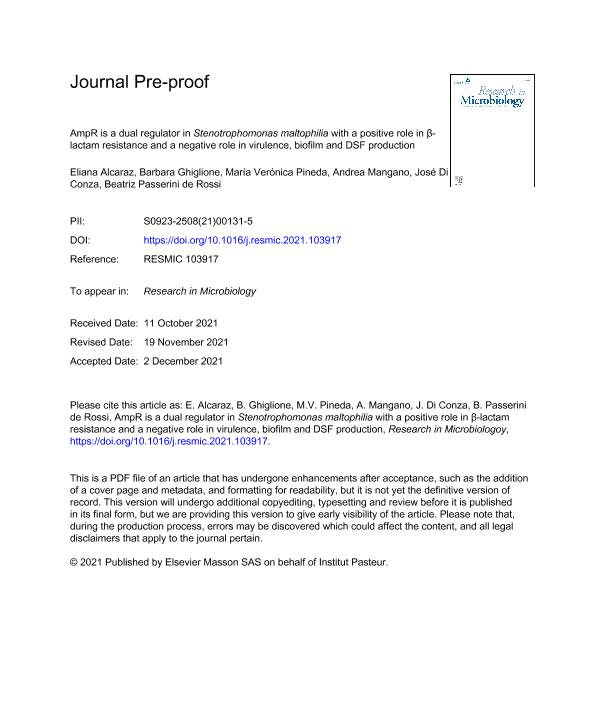Artículo
AmpR is a dual regulator in Stenotrophomonas maltophilia with a positive role in β-lactam resistance and a negative role in virulence, biofilm and DSF production
Alcaraz, Eliana Sabrina; Ghiglione, Barbara ; Saliba Pineda, Maria Verónica; Mangano, Andrea María Mercedes
; Saliba Pineda, Maria Verónica; Mangano, Andrea María Mercedes ; Di Conza, José Alejandro
; Di Conza, José Alejandro ; Passerini de Rossi, Beatriz Noemi
; Passerini de Rossi, Beatriz Noemi
 ; Saliba Pineda, Maria Verónica; Mangano, Andrea María Mercedes
; Saliba Pineda, Maria Verónica; Mangano, Andrea María Mercedes ; Di Conza, José Alejandro
; Di Conza, José Alejandro ; Passerini de Rossi, Beatriz Noemi
; Passerini de Rossi, Beatriz Noemi
Fecha de publicación:
04/2022
Editorial:
Elsevier Science
Revista:
Research In Microbiology
ISSN:
0923-2508
Idioma:
Inglés
Tipo de recurso:
Artículo publicado
Clasificación temática:
Resumen
Stenotrophomonas maltophilia intrinsic resistance to β-lactams is mediated by two chromosomal β-lactamases, L1 and L2, whose induction depends on AmpR. Its quorum sensing (QS) signal, the diffusible signal factor (DSF), has a positive role in biofilm production, virulence and induction of β-lactamases. We hypothesized that AmpR has a role in virulence, biofilm production and QS system. Studies were done on S. maltophilia K279a, K279a ampRFS (ampR deficient mutant) and K279aM11 (constitutively active AmpR mutant). K279a ampRFS showed the highest biofilm biomass, thickness and 3D organization. Conversely, K279aM11 was the least efficient biofilm former strain. qRT-PCR showed that spgM, related to biofilm formation and virulence, was upregulated in K279a ampRFS and downregulated in K279aM11. A constitutively active AmpR led to a reduction of DSF production, while K279a ampRFS was the highest producer. Consequently, qRT-PCR showed that AmpR negatively regulated rpfF expression. K279a ampRFS presented the highest oxidative stress resistance, overexpressed sodA gene and showed the highest virulence in the Galleria mellonella killing assay. This is the first evidence of the function of AmpR as a dual regulator in S. maltophilia with a positive role in β-lactam resistance and a negative role in DSF production, biofilm formation, oxidative stress resistance and virulence.
Palabras clave:
STENOTROPHOMONAS MALTOPHILIA
,
DSF
,
BIOFILM
,
RESISTANCE
Archivos asociados
Licencia
Identificadores
Colecciones
Articulos(OCA HOUSSAY)
Articulos de OFICINA DE COORDINACION ADMINISTRATIVA HOUSSAY
Articulos de OFICINA DE COORDINACION ADMINISTRATIVA HOUSSAY
Citación
Alcaraz, Eliana Sabrina; Ghiglione, Barbara; Saliba Pineda, Maria Verónica; Mangano, Andrea María Mercedes; Di Conza, José Alejandro; et al.; AmpR is a dual regulator in Stenotrophomonas maltophilia with a positive role in β-lactam resistance and a negative role in virulence, biofilm and DSF production; Elsevier Science; Research In Microbiology; 173; 3; 4-2022; 1-34
Compartir
Altmétricas



